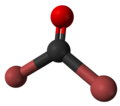| |||
| Names | |||
|---|---|---|---|
| Preferred IUPAC name Carbonyl dibromide | |||
| Other names Bromophosgene, carbonic dibromide | |||
| Identifiers | |||
3D model (JSmol) | |||
| ChemSpider | |||
PubChem CID | |||
| UNII | |||
CompTox Dashboard (EPA) | |||
| |||
| |||
| Properties | |||
| COBr2 | |||
| Molar mass | 187.818 g·mol−1 | ||
| Appearance | colorless liquid | ||
| Density | 2.52 g/mL at 15 °C | ||
| Boiling point | 64.5 °C (148.1 °F; 337.6 K) decomposes | ||
| reacts | |||
| Thermochemistry | |||
Heat capacity (C) | 61.8 J/(mol·K) (gas) | ||
Std molar entropy (S⦵298) | 309.1 J/(mol·K) (gas) | ||
Std enthalpy of formation (ΔfH⦵298) | −127.2 or −145.2 kJ/mol (liquid) −96.2 or −114 kJ/mol (gas) | ||
| Hazards | |||
| NFPA 704 (fire diamond) | |||
| Related compounds | |||
Related compounds | Carbonyl fluoride Phosgene | ||
Except where otherwise noted, data are given for materials in their standard state (at 25 °C [77 °F], 100 kPa). | |||
Carbonyl bromide, also known as bromophosgene, is a carbon oxohalide and a bromine analogue of phosgene, with the chemical formula COBr2. It is a colorless liquid. Carbonyl bromide is a decomposition product of halon compounds used in fire extinguishers. [2]


